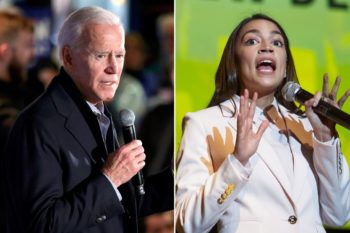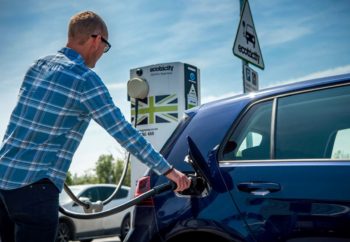
Biden, who on Thursday evening will formally accept the Democratic Party’s nomination for the presidency, has largely avoided the limelight, campaigning via teleconference from his home in Delaware.
But from that home, he has planned an administration on par with Franklin Roosevelt’s, including a massive investment of taxpayer dollars in a climate plan which, one expert told the Washington Free Beacon, would be “unachievable, fantastically expensive, and environmentally destructive.”
That plan includes Green New Deal-style proposals such as a “civilian climate corps” and the mass retrofitting of America’s homes and vehicles.
It also reproduces key features of President Barack Obama’s environmental agenda, including a focus on regulating consumer products and the return of the questionably effective “cash for clunkers” program.
And it incorporates many of the concerns of the Democratic Party’s activist base, including a separate plan for pursuing “environmental justice” by targeting federal subsidies to minority groups.
The proposal is clearly influenced by Biden’s more progressive 2020 challengers, particularly Washington governor Jay Inslee (D.), who ran on a climate-focused platform.
It also broadly mirrors the recommendations of the climate section of the Biden-Sen. Bernie Sanders (I., Vt.) unity task force, co-chaired by former secretary of state John Kerry and Rep. Alexandria Ocasio-Cortez (D., N.Y.).
Although Biden has not publicly endorsed Ocasio-Cortez or others’ official Green New Deal proposals, the elements of his climate platform indicate this major piece of his presidential agenda is heavily influenced by the Democratic Party’s far-left flank, one of the many places he’s been pulled left over the course of the year.
They also suggest that a Biden administration would see its ambit to fight climate change—and, as Biden recently put it, to “rewrite our economy”—as essentially unlimited.
Biden’s campaign has released three separate proposals pertaining to the environment, indicating the intensity with which he is focused on the issue. Biden superseded his original $1.7 trillion climate plan with a $2 trillion proposal released in July as part of his vision for the post-coronavirus economic recovery.
Both of the plans incorporate elements of his “environmental justice” plan, a separate slate of proposals focused on the intersection of climate policy and racism.
The plans all share a common goal: making the U.S. economy carbon neutral by 2050. They include several milestones along the way, including zero-emission public buses by 2030 and zero-emission power generation by 2035.
(None of the targets come before the end of Biden’s would-be term in 2025, although he does indicate he will “establish … an enforcement mechanism that includes milestone targets no later than the end of his first term in 2025.”)
Benjamin Zycher, an energy economist at the American Enterprise Institute, told the Free Beacon that Biden’s goals were “pretty similar to the Green New Deal,” labeling them “unachievable, fantastically expensive, and environmentally destructive.”
Zycher noted that a transition away from fossil fuels to renewables would be impossible under current conditions because limited battery capacity and the constant demand for power means that grids would be subject to rolling blackouts when the sun is not shining or the wind is not blowing.
(Biden’s plan does include the use of nuclear power to mitigate this problem, for which activists have criticized him.)
He also said that “clean” energy generation is not always environmentally friendly, citing heavy metal pollution and the generation of toxic waste.
Biden’s plans float a number of approaches to achieving the 2050 neutral goal. Highlights include the imposition of new emission standards on vehicles and household appliances—a major focus of Obama’s EPA, which President Donald Trump has sought to roll back.
The plan also heavily emphasizes retrofitting American homes and other buildings as a major priority, a part of the broader “green jobs” mandate—including a “Civilian Climate Corps”—which the Biden plan shares with GND proposals.
Even changes at the scale Biden envisions are unlikely to have a major impact on the climate—Zycher has estimated net-zero emissions by 2050 would cut global temperature by 0.2 degrees centigrade by 2100—in large part because the United States accounts for just 15 percent of global emissions, slightly more than half of China’s output.
In response to this reality, Biden’s plan also calls for added international cooperation, including rejoining the Paris Climate Agreement, from which Trump previously withdrew and which Zycher has estimated would cut global temperatures by just 0.17 degrees, at a cost of one percent of global GDP.
Smaller features of Biden’s plans surprisingly recall failed attempts at environmental interventions staged by the Obama administration.
He floats a “consumer rebates” plan to swap less efficient vehicles for more efficient ones, recalling the infamous “Cash for Clunkers” program, which analysis from the left-leaning Brookings Institution found had little effect on either emissions or jobs.
Biden’s plan also features mass weatherization of American homes, which was included in the 2009 stimulus bill, but which led to only a fraction of the homes having been weatherized by 2010.
In addition to his climate plans, Biden intends to crack down aggressively on polluting and other perceived environmental infractions by the American business community, all in the name of combating “racial injustice.”
His “environmental justice” plan would set up an environmental justice division within the DOJ and substantially expand the ambit of the EPA’s External Civil Rights Compliance Office.
The environmental justice proposal also explicitly ties Biden’s climate goals to the Democratic party’s messaging on race.
Under his proposal, 40 percent of “investment in a clean energy revolution” would be earmarked for “disadvantaged communities.”
This increased regulatory pressure would mean “more uncertainty for businesses,” James Broughel, an expert on federal regulation at the libertarian-leaning Mercatus Center, told the Free Beacon.
“I think right now, businesses feel like they have an ally in the White House, and that gives them confidence to go forward with their plans and invest,” Broughel said.
“If they feel like they are in an antagonistic relationship with the administration in power, then that tees us up for more uncertainty in the economy, that certainly adds costs in terms of the overall regulatory burden and makes businesses less optimistic and less likely to invest and hire people.”
Read more at Free Beacon

















To say using only “green energy” for electricity is the height of stupidity. It’s one thing to have rolling blackouts in the summer (we survived w/o AC when I was a kid growing up in Arkansas) but I would like to hear an explanation of how we keep from freezing to death in the middle of winter when it is bitter cold with no wind and the sun is up for very few hours (such as happened last winter in Minnesota). Without the fossil fuel power plants there would have been many peopled dead in their homes.
Biden like just about all Liberal Democrats are all for a Bigger Government and more regulations